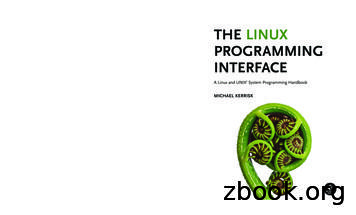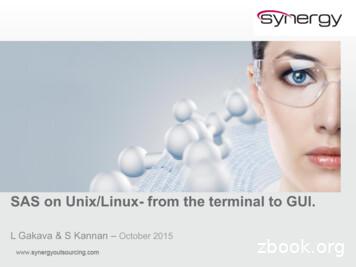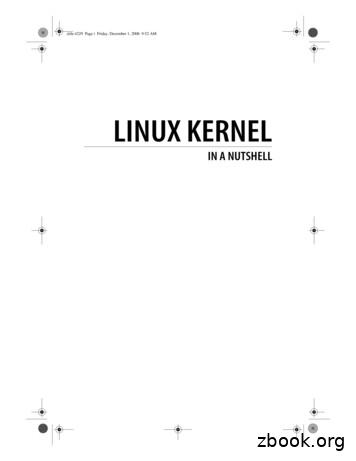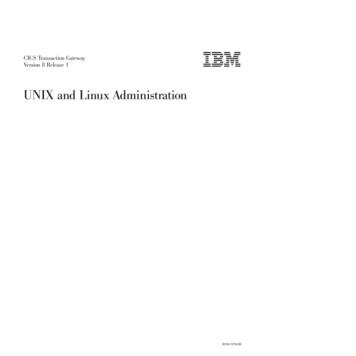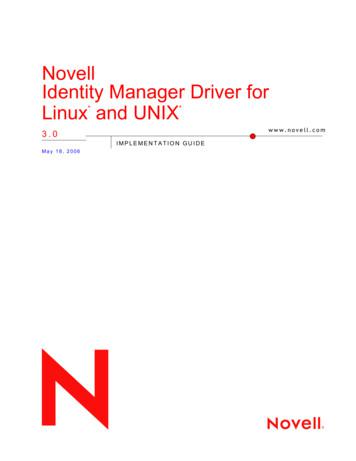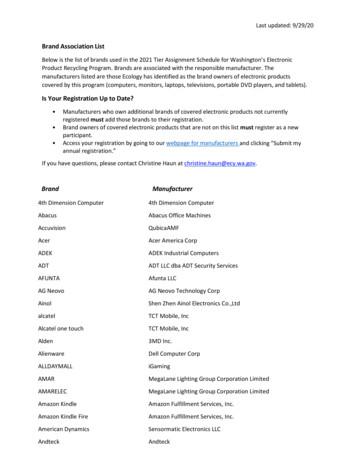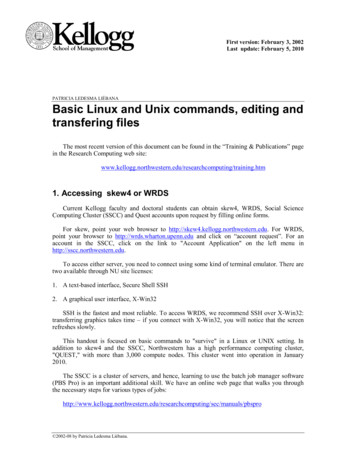Unix, Linux, Android
Unix, Linux, Android2020-07-07 22:51Unix, Linux, AndroidTable of Contents History–––––––MULTICSPDP-11 UNIXPortable UNIXBerkeley UNIXPOSIXMINIXLinux Linux Overview– Linux Goals– Interfaces Kernel Structure– I/O Component– Interdependence– System call interface ss DescriptorExecuting lsKernel Threads and clone Scheduling– Linux O(1) Scheduler– Completely Fair Scheduler (CFS) Boot Process– Dynamic Loading– init Memory Management1
Unix, Linux, Android––––––––2020-07-07 22:51System CallsImplementationPhysical memoryPaging SchemeMemory-AllocationRepresentation of Virtual Address SpacePagingPage Frame Reclaiming AlgorithmHistoryMULTICS 1940s-1950s: book time on a computer 1960s: batch systems where you leave your punched cards at the machine room– long delay between submitting and getting the output– debugging immensely difficult timesharing invented at Dartmouth College and MIT MULTICS: Multiplexed Information and Computing Service: developed by Bell Labs and GE,before Bell Labs pulled out Ken Thompson: Bell Labs researcher writes stripped-down MULTICS in assembly on a PDP-7 Brian Kernighan referred to it as UNICS (Uniplexed Information and Computing Service,which eventually became UNIXPDP-11 UNIX UNIX was moved to PDP-11, which was a powerful machine and large memory, with memoryprotection hardware, allowing multi-user support Thompson rewrote UNIX in high-level language he designed, B. But it lacked structures makingit insufficient. Dennis Ritchie designed successor C and a compiler Thompson and Ritchie then rewrite UNIX in C, publishing landmark paper The UNIX TimeSharing System in 1974 Bell Labs, owned by AT&T, as a regulated monopoly was not allowed to be in the computer business, so licensed UNIX to universities for a modest fee. At the time, most universities had PDP11s, and the OS that came with them was terrible, so UNIX came in at the right time.2
Unix, Linux, Android2020-07-07 22:51Portable UNIX porting UNIX to a new machine was made much simpler once it was written in C. The processinvolves:– writing a C compiler for the new machine– writing device drivers for the new machine’s I/O devices– small amount of machine-dependent code for interrupt handlers/memory managementin assembly processing of porting to an Interdata machine revealed lots of assumptions implicitly made byUNIX about integers being 16 bits, pointers, being 16 bits, etc. UNIX had to be cleaned up tomake it portable. a portable C compiler was implemented, allowing easy modification for any machine with moderate effort AT&T was broken up in 1984 by the US government, and accordingly established a computersubsidiary, releasing commercial UNIX product (System III/V)Berkeley UNIX source code for UNIX was available, so Berkeley heavily modified it, with funding from ARPA 4BSD (Fourth Berkeley software distribution) introduced many improvements–––––virtual memory and paginglonger file namesreimplemented file system with improved performanceincreased signal handling reliabilityintroduced networking causing TCP/IP protocol stack to become de facto standard in UNIXworld added a number of utility programs: vi, csh, Pascal and Lisp compilers, some vendors subsequently based their UNIX off Berkely UNIX rather than System VPOSIXIEEE 1003.1-2017 late 1980s: 4.3BSD and System V Release 3 were both in widespread use and were somewhatincompatible, with each vendor additionally complicating matters with their own non-standardenhancements3
Unix, Linux, Android2020-07-07 22:51 prevented commercial success as software vendors could not package UNIX programs and guarantee that they would run on any system, as was the case with MS-DOS attempts were made to standardise, e.g. by AT&T issuing the SVID (System V Interface Definition),however this was only relevant to System V vendors and ignored by BSD IEEE Standards Board came together with industry, academia, and government to producePOSIX, a Portable Operating System, defined in standard 1003.1 1003.1 defines a set of library procedures that every conformant UNIX system must supply. Mostprocedures invoke a system call (e.g. open, read, fork), but some can be implemented outside the kernel as a result a vendor writing a program using only procedures defined by 1003.1 knows that thisprogram will run on every conformant UNIX system approach taken by IEEE was unusual in that it took the intersection of System V and BSD, ratherthan the union, such that 1003.1 looks lie a common ancestor of both OSs related documents standardise threads, utilities, networking, C has also been standardised by ISO/ANSIMINIX modern UNIX is large and complicated, the antithesis of the original conception of UNIX 1987: MINIX was produced as a UNIX-like system that was small enough to understand, with11,800 lines of C and 800 lines of assembly MINIX used microkernel design, providing minimal functionality in the kernel so that it is reliableand efficient. Memory management and file system become user processes, while the kernelhandles message passing between processes and not much else––––Kernel: 1600 lines of code 800 lines of assemblerI/O device drivers: 2900 lines of C, also in kernelFile system: 5100 lines of CMemory manager: 2200 lines of C microkernels vs monolithic:– the former is easier to understand and maintain, with a highly modular structure– highly reliable: a crash of a user mode process does much less damage than a kernel-modecrash– lower performance due to extra switches between user/kernel mode 2004: direction of MINIX development changed to focus on building an extremely reliable anddependent system that could automatically repair faults– all device drivers were moved to user space, each running as a separate process4
Unix, Linux, Android2020-07-07 22:51– kernel was under 4000 lines of code has been ported to ARM, so it is available for embedded systemsLinux many features were requested for MINIX but these were often denied due to the goal of keepingthe system small 1991: Linus Torvalds wrote Linux as a UNIX clone, intending for it to be a full production system– monolithic, with the entire OS in the kernel– initially 9,300 lines of C 950 lines of assembly 1994: v1.0, 165,000 lines of code1996: v2.0, 470,000 lines of C, 8000 lines of assembly2013: 16 million lines of codeversion A.B.C.D:––––A: kernel versionB: major versionC: minor revision, e.g. support for new driversD: minor bug fixes and security patches issued under GPL (GNU Public License), permitting you to use, copy, modify, and redistribute thesource and binary code freely. All derivatives of the Linux kernel may not be sold/redistributedin binary form only, they must be shipped with source code 1992: Berkeley terminated BSD development, releasing 4.4BSD– FreeBSD was based off this– Berkeley issued software under an open source license– AT&T subsidiary sued Berkeley, keeping FreeBSD off the market for long enough for Linuxto become well established– had this not happened, Linux would have an immature OS competing with mature andstable systemLinux OverviewLinux Goals UNIX: interactive system for multiple processes and multiple users, designed by programmersfor programmers5
Unix, Linux, Android2020-07-07 22:51Goals simplicityeleganceconsistencypowerflexibilityavoid useless redundancyExamples files should just be a collection of bytes, not with different classes principle of least surprise: e.g. ls *A and rm *A should be predictable and small number of basic elements should be able to be combined infinite ways as neededInterfaces operating system runs on bare hardware, controling the hardware and provides system callsinterface to programs system calls allow users to create and manage processes, files, resources programs make system calls by putting arguments in registers and issuing trap instructions. Asthere is no way to write a trap instruction in C, a standard library is provided with one procedureper system call standard library is written in assembly but can be called from C POSIX specifies the library interface, not the system call interface Linux also supplies standard programs, some of which are specified by 1003.2, which get invoked by the user6
Unix, Linux, Android2020-07-07 22:51Figure 1: linux-interfaces GUIs are supported by X windowing system (X11/X), defining communication and display protocols for window manipulation on bitmap displays X server: controls devices and redirects I/O GUI environment built on top of low-level library xlib which contains functionality to interactwith the X server– graphical interface extends functionality of X11 by enriching window view: e.g. buttons,menus, – xterm: terminal emulator program, providing basic command-line interface to OS7
Unix, Linux, Android2020-07-07 22:51Kernel StructureFigure 2: linux-kernel interrupt handlers: primary way of interacting with devices dispatching occurs as the result of an interrupt: code stops running process, saves its state andstarts the appropriate driver– written in assemblerI/O Component I/O component: responsible for interacting with devices, network, storage I/O operationsI/O operations are integrated under a Virtual File System (VFS) layerat the low-level all I/O operations pass through a device driverdrivers are either character/block-device, depending on whether they are random access or not,and network devices, while a form of character devices are sufficiently different to considerthem a different category8
Unix, Linux, Android2020-07-07 22:51 character devices used in 2 ways:– every keystroke: e.g. vim– line oriented: e.g. bash. The character stream is passed through a line discipline network devices:– above network drivers is full functionality of hardware router– above routing code is protocol stack (including IP/TCP)– above this is the socket interface, allowing programs to create sockets block devices:– I/O scheduler orders/issues disk-operation requests per some system policy– file system: Linux has multiple file systems concurrently, so to abstract away architecturaldifferences, a generic block-device layer is used by all file systemsInterdependence 3 components are interdependent e.g. page caches may be used to hide latencies of accessing files: block device dependent onmemory manager e.g. virtual memory relies on swap area: memory manager dependent on I/OSystem call interface all system calls come here, causing a trap which switches execution from user mode into protected kernel mode, passing control to one of the kernel componentsProcesses each process runs a single program, starting with 1 thread of controlprocess group: ancestors, siblings, descendantsdaemon: background process e.g. cron daemon for scheduling jobscreated by forkpipe: channel for two processes to communicate, one process can write a stream of bytes forthe other to read– when a process tries to read an empty pipe, the process is blocked until data is available zombie state: process exits, and parent has not waited for it. When parent calls wait for it, theprocess terminates9
Unix, Linux, Android2020-07-07 22:51Signals signal: software interrupt for one process to send signal to another process processes catching signals must specify signal-handling procedure when a signal arries, control abruptly switches to the handler. After finishing, control returns tothe previous location processes can only send signals to members of its process group sigaction: syscall for a process to announce signal-handler for a particular signal kill: syscall for a process to signal another related process– uncaught signals kill the recipient alarm: syscall for a process to be interrupted after a specific time interval with SIGALRM pause: suspends process until next signal arrivesImplementation every process has a user part running the user program when a thread makes a syscall it traps to kernel mode and begins running in kernel context, witha different memory map, and full access to machine resources this is still the same thread, but with more power and its own kernel mode stack and programcounter kernel represents any execution context (thread, process) as a task via task struct,– multithreadd process has one task structure for each user level thread kernel is multithreaded, having kernel-level threads– executing kernel code– not associated with any user processes task structs are in memory for each process at all times, stored as a doubly linked list there is also a hashmap from PID to the address of the task structure for quick lookup. This useschaining in case of collisions.Process Descriptor scheduling parameters: process priority, CPU time used, time sleepingmemory image: pointers to text, data, stack, page tablessignals: mask indicate which signals are caught/ignored/deliveredmachine registers: when a trap occurs, machine registers are stored ere10
Unix, Linux, Android 2020-07-07 22:51syscall state: info about the current system callfile descriptor table: table mapping between file descriptor and file’s i-nodeaccounting: keep track of CPU time used by the processkernel stack: fixed stack, for use by kernel part of processmiscellaneous: process state, event being waited for, PID, parent PID, UID, GUIDExecuting lsFigure 3: executing-lsKernel Threads and clone kernel threads in Linux differ from the standard UNIX implementation in UNIX, processes are resource containers, and threads units of execution. Processes contain1 threads, sharing address space, open files, signal handlers, alarms, 11
Unix, Linux, Android2020-07-07 22:51 clone: introduced in Linux in 2000, blurring the distinction between threads and processes,allowing parameters to be specified as process specific or thread specific1pid clone(function, stack ptr, sharing flags, arg);Whether a clone call creates a new thread in the current process or in a new process is dependent onsharing flags, which is a bitmap allowing fine-grained control over what gets shared.Figure 4: sharing-flag-bitmap divergence from UNIX, meaning Linux code using clone is no longer portable to UNIXLinux stores in task struct both the process identifier PID and task identifier TIDwhen clone creates a new task sharing nothing with the creator, and PID is set to a new valueotherwise clone creates a task receives a new TID but inherits the PIDScheduling As Linux threads are kernel threads, scheduling is based on threads, not processesrunnable tasks are stored in the runqueue, associated with each CPUtasks which are not runnable are stored in the waitqueue140 priority values:– 0: highest priority– 139: lowest priority 3 classes of threads:– real-time FIFO: highest priority 0-99, not preemptable except by a newly readied real-timeFIFO thread with higher priority– real-time round robin: highest priority 0-99, preemptable by the clock, having an associated time quantum– timesharing: lower priority 100-139, conventional threads12
Unix, Linux, Android2020-07-07 22:51 NB these are not actually real-time threads, in terms of a deadline guarantee. The naming is forconsistency with standards nice(value): syscall to adjust static priority of a thread, where value ranges from -20 to 19Linux O(1) Scheduler historically popular scheduler, but the heuristics were complex and imperfect, producing poorperformance for interactive tasks constant time to select/enqueue tasks the runqueue uses two arrays, active and expired, storing the heads of a linked list, each corresponding to 1 of 140 priority levels scheduler selects task from highest-priority list in active array after the task’s quantum has expired, it is moved to the expired list, possibly with a differentpriority level a task that blocks is placed on the waitqueue until it is ready again, at which point it is enqueuedon the active array when there are no more tasks in the active array, the pointers are swapped to make the expiredarray the active array higher priority levels are assigned higher quanta to get processes out of the kernel quickly interactivity heuristics: dynamic priority is continuously recalculated to reward interactivethreads and punish CPU-hogging threads (-5 to 5 penalty)Completely Fair Scheduler (CFS) uses a red-black tree as the runqueue tasks are ordered based on amount of CPU time they have spent, vruntime, measured innanoseconds left children have had less time on CPU and will be scheduled sooner than right children schedule the task which has had the least CPU time (typically left-most node) CFS periodically increments vruntime of the task, with the effective rate adjusted accordingto the task’s priority: low priority tasks have time pass more quickly. This avoids maintainingseparate runqueues for different priorities selection of a node: constant time 𝑂(1) insertion of a node: 𝑂(log 𝑛)13
Unix, Linux, Android2020-07-07 22:51Figure 5: linux-schedulingBoot Process BIOS performs Power-On-Self-Test (POST) and initial device discovery and initialisation Master Boot Record first sector of the boot disk, is read into a fixed memory location and executed execution of MBR program loads a standalone boot program from the boot device boot is then run– copies itself to a fixed high memory address, freeing low memory for the OS– reads root directory of the boot device– reads in OS kernel and jumps to it. Kernel is running kernel start-up code is written in assembly, so is highly machine dependent14
Unix, Linux, Android––––––2020-07-07 22:51setting up kernel stackidentify CPUcalculate RAM presentdisable interruptsenable MMUcall C-language main procedure to start main part of the OS kernel data structures are allocated: page cache, page tables autoconfiguration: probe for present devices and add them to a table– device drivers can be loaded dynamically set up process 0 (idle process), set up its stack, and run it––––initialisation: e.g. program real-time clockmount root file systemcreate init (process 1)create page daemon (process 2) init checks if it is single/multiuser:– single: fork a process executing the shell, and wait for it to exit– multi:* fork a process that executes system initialisation shell script /etc/rc,* read /etc/ttys to list terminals and their properties* fork a copy of itself for each terminal, then execute getty if someone tries to login, getty executes /bin/login, which requests credentials if authenticated, login replaces itself with the shell15
Unix, Linux, Android2020-07-07 22:51Figure 6: linux-booting terminal 0: getty is waiting for input terminal 1: user has typed login name, so getty has overwritten itself with login terminal 2: successful login has occurred, so login has replaced itself with /bin/sh, which hasprinted the prompt. The user has typed cp f1 f2, causing the shell to fork off a child processexecuting cp. The shell is blocked, waiting for the child to terminate.Dynamic Loading traditional UNIX: static linking of drivers dynamic loading allows you to ship a single binary for multiple configurations, with the systemautomatically loading the drivers it needs, possibly obtaining them over the network downside: this creates security vulnerabilitiesinitWiki: Init16
Unix, Linux, Android2020-07-07 22:51Memory Management each process has an address space with three logical segments: text, data, stack text: machine instructions that form the program’s executable code, read only data: variables, strings, arrays. Two parts: initialised and uninitialised data– initialised data: variables and compiler constants that have an initial value when the program starts. Similar to program text, bit patterns produced by the compiler– Block Started by Symbol (BSS): uninitialised data– data segment can be increased in size by system call brk* heavily used by malloc* heap is dynamically allocated memory area stack: starts at/near top of virtu
Unix,Linux,Android 2020-07-0722:51 Unix,Linux,Android TableofContents History – MULTICS – PDP-11UNIX – PortableUNIX – BerkeleyUNIX – POSIX – MINIX – Linux LinuxOverview – LinuxGoals – Interfaces KernelStructure – I/OComponent – Interdependence – Systemcallinterface Processes – Signals – Implementation .
Linux in a Nutshell Linux Network Administrator’s Guide Linux Pocket Guide Linux Security Cookbook Linux Server Hacks Linux Server Security Running Linux SELinux Understanding Linux Network Internals Linux Books Resource Center linux.oreilly.comis a complete catalog of O’Reilly’s books on Linux and Unix and related technologies .
Unix 101: Introduction to UNIX (i.e. Unix for Windows Users) Mark Kegel September 7, 2005 1 Introduction to UNIX (i.e. Unix for Windows Users) The cold hard truth · this course is NOT sponsored by the CS dept. · you will not receive any credit at all introduce ourselv
Android Studio IDE Android SDK tool Latest Android API Platform - Android 6.0 (Marshmallow) Latest Android API emulator system image - Android 6.0 Android Studio is multi-platform Windows, MAC, Linux Advanced GUI preview panel See what your app looks like in different devices Development environment Android Studio 9
The Linux Programming Interface is the definitive guide to the Linux and UNIX programming interface—the interface employed by nearly every application that runs on a Linux or UNIX system. In this authoritative work, Linux programm
Hello, this is Linus Torvalds, and I pronounce Linux as Linux! Inspired by the UNIX OS, the Linux kernel was developed as a clone of UNIX GNU was started in 1984 with a mission to develop a free UNIX-like OS Linux was the best fit as the kernel for the GNU Project Linux kernel was passed onto many interested developers throughout the
o Company migrating to UNIX/Linux o Joining a company which is using SAS on the Linux platform Challenge Too many commands to learn! Why Use SAS On Unix/Linux o Customising Linux sessions will ensure you increase work efficiency by taking advantage of the imbedded Linux tools. In general transferring and running large files will be quicker in .
Other Linux resources from O’Reilly Related titles Building Embedded Linux Systems Linux Device Drivers Linux in a Nutshell Linux Pocket Guide Running Linux Understanding Linux Network Internals Understanding the Linux Kernel Linux Books Resource Center linu
UNIX is one of the ground-breaking operating systems from the early days of computing. Mac OS X is built on top of UNIX. Linux is a variation of UNIX. The shell is the command line interface for running UNIX (and Mac OS X and Linux) with just typing (no mouse).
UNIX and POSIX APIs: The POSIX APIs, The UNIX and POSIX Development Environment, API Common Characteristics. UNIT – 2 6 Hours UNIX Files: File Types, The UNIX and POSIX File System, The UNIX and POSIX File Attributes, Inodes in UNIX
UNIX and Linux Administration SC34-7216-00. CICS Transaction Gateway Version 8 Release 1 UNIX and Linux Administration . Other system factors .180 iv CICS Transaction Gateway for Multiplatforms V8.1: UNIX and Linux Administration. Performance considerations for heavy IPIC
The Identity Manager Driver for Linux and UNIX 3.0 synchronizes data between the Identity Vault and a connected Linux or UNIX system. This guide is organized into the following sections: Chapter 1, "Overview," on page 11 Chapter 2, "Planning for the Linux and UNIX Driver," on page 17
2 LXC DOCKER MICHAEL LESSARD A bit of history - Virtualization and containers Chroot (version 7 Unix, 1979) FreeBSD Jails (FreeBSD 4, 2000) Linux vserver (Linux, Oct 2001) Para-virtualization Xen (Linux, 2003) Solaris zones (Solaris 10, 2004) OpenVZ (Linux, 2005) Full virtualization KVM (Linux, 2007) Linux Containers - LXC (Linux 2.6.29 2009)
Unix was originally developed in 1969 by a group of AT&T employees Ken Thompson, Dennis Ritchie, Douglas McIlroy, and Joe Ossanna at Bell Labs. There are various Unix variants available in the market. Solaris Unix, AIX, HP Unix and BSD are a few examples. Linux is also a flavor of Unix which is freely available.
UNIX system services UNIX kernel in C computer SH The shell (sh) is a program (written in C) that interprets commands typed to it, and carries out the desired actions. The shell is that part of Unix that most users see. Therefore there is a mistaken belief that sh is Unix. sh is an applications program running under Unix
Android is not Linux (i.e. Uses own libraries, tools, ) Android is a complete stack on top of the Linux kernel Software Platform versus OS Android is an application framework on top of Linux facilitating rapid deployment in many domains Android is the enabler for a broad application developer base Android is Open .
Perfection PC Perfection PC Inc. Philips Philips Electronics Planar Planar Systems Inc PLEXON Plexon, Inc. Pogo Linux Pogo Linux, Inc. Pogo Linux Altura M2 Pogo Linux, Inc. Pogo Linux Velocity -D50 Pogo Linux, Inc. Pogo Linux Verona 330 Pogo Linux, Inc. Pogo Linux Vor
4. Linux/UNIX “personality” A few Linux/UNIX rules to remember: UNIX treats everything (hardware, directories, etc) like a file. Think of a screen or a printer as “write-only” files, keyboards as “read-only” files, etc. UNIX commands are case sensitive and they are generally all in lower case.
The Linux Programming Interface is the definitive guide to the Linux and UNIX programming interface—the interface employed by nearly every application that runs on a Linux or UNIX system. In this authoritative work, Linux programm
UNIX ili Linux operativnog sistema. Knjiga je podeljena u etrnaest glava, koje su ukratko opisane u nastavku teksta. U prvoj glavi ”UVOD U UNIX OPERATIVNI SISTEM” opisan je krai istorijat UNIX i Linux operativnih sistema, razjašnjeni su pojmovi GNU GPL licence i Open Source
asset management for utilities and telecommunication providers to support network planning, design and analysis, maintenance and operations. OMS and DMS integration: A configurable standards-based software solution that provides utilities with an automated way of introducing the electric network to the OMS (Outage Management System) and DMS (Distribution Management System) via CIM (Common .




